Leadership and Change Management: Mid-Staffordshire NHS Trust Analysis
VerifiedAdded on 2021/04/19
|16
|4082
|102
Report
AI Summary
This report provides a comprehensive analysis of leadership and change management within the Mid-Staffordshire NHS Trust. It begins with an introduction that highlights the importance of understanding change in the healthcare industry. The report then conducts a stakeholder evaluation of the trust, examining the roles and influence of various groups, including hospital boards, employees, patients, and trade unions. The study identifies key change drivers, such as system failures, non-compliance with standards, and communication breakdowns, which led to organizational changes. It also explores the barriers to change, including poor communication, lack of employee involvement, and inadequate planning. Furthermore, the report evaluates the leadership approaches adopted by managers, focusing on strategies such as setting new responsibilities, regulatory reforms, and implementing effective communication strategies. The report concludes by offering insights into how leadership and change management can be improved within healthcare organizations, drawing on the lessons learned from the Mid-Staffordshire NHS Trust case.
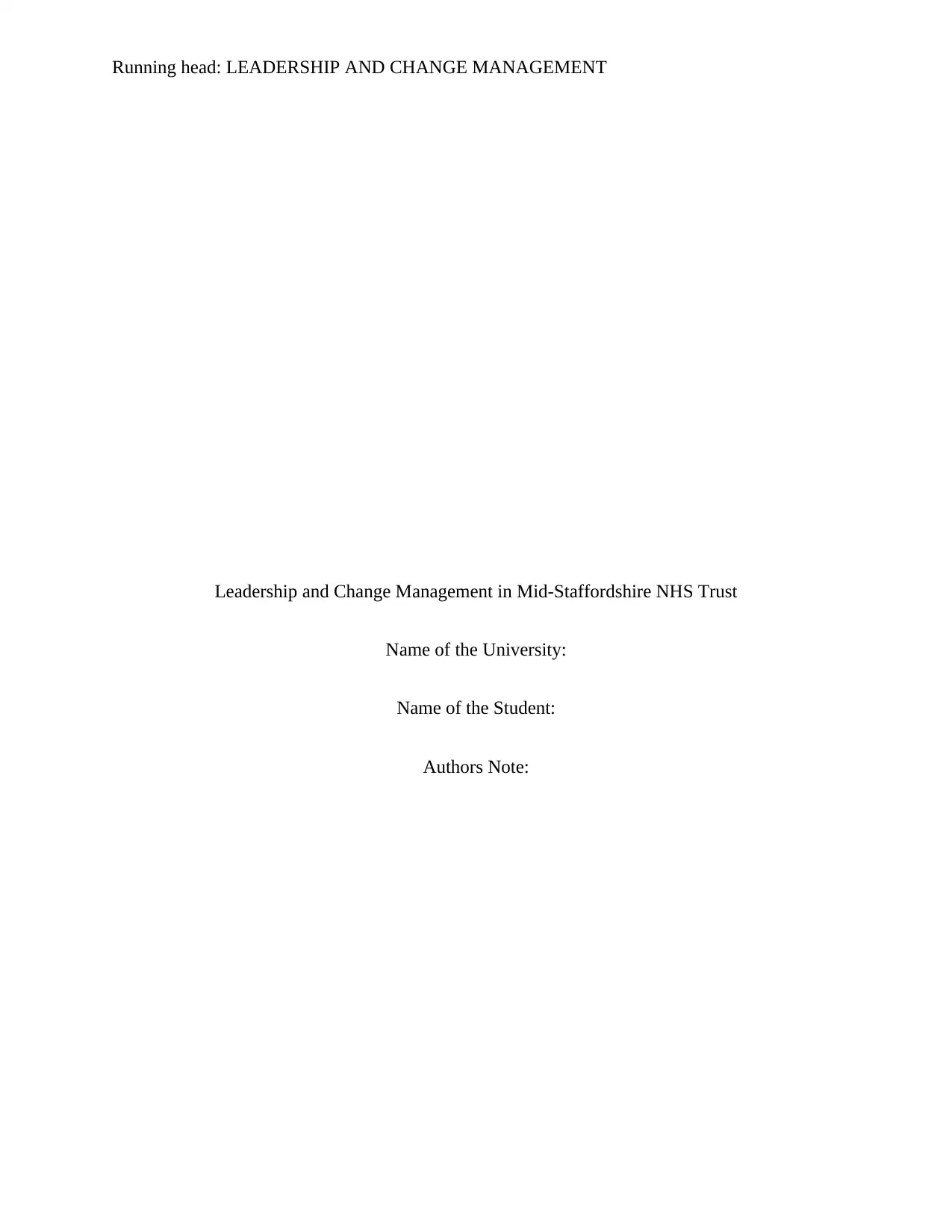
Running head: LEADERSHIP AND CHANGE MANAGEMENT
Leadership and Change Management in Mid-Staffordshire NHS Trust
Name of the University:
Name of the Student:
Authors Note:
Leadership and Change Management in Mid-Staffordshire NHS Trust
Name of the University:
Name of the Student:
Authors Note:
Paraphrase This Document
Need a fresh take? Get an instant paraphrase of this document with our AI Paraphraser
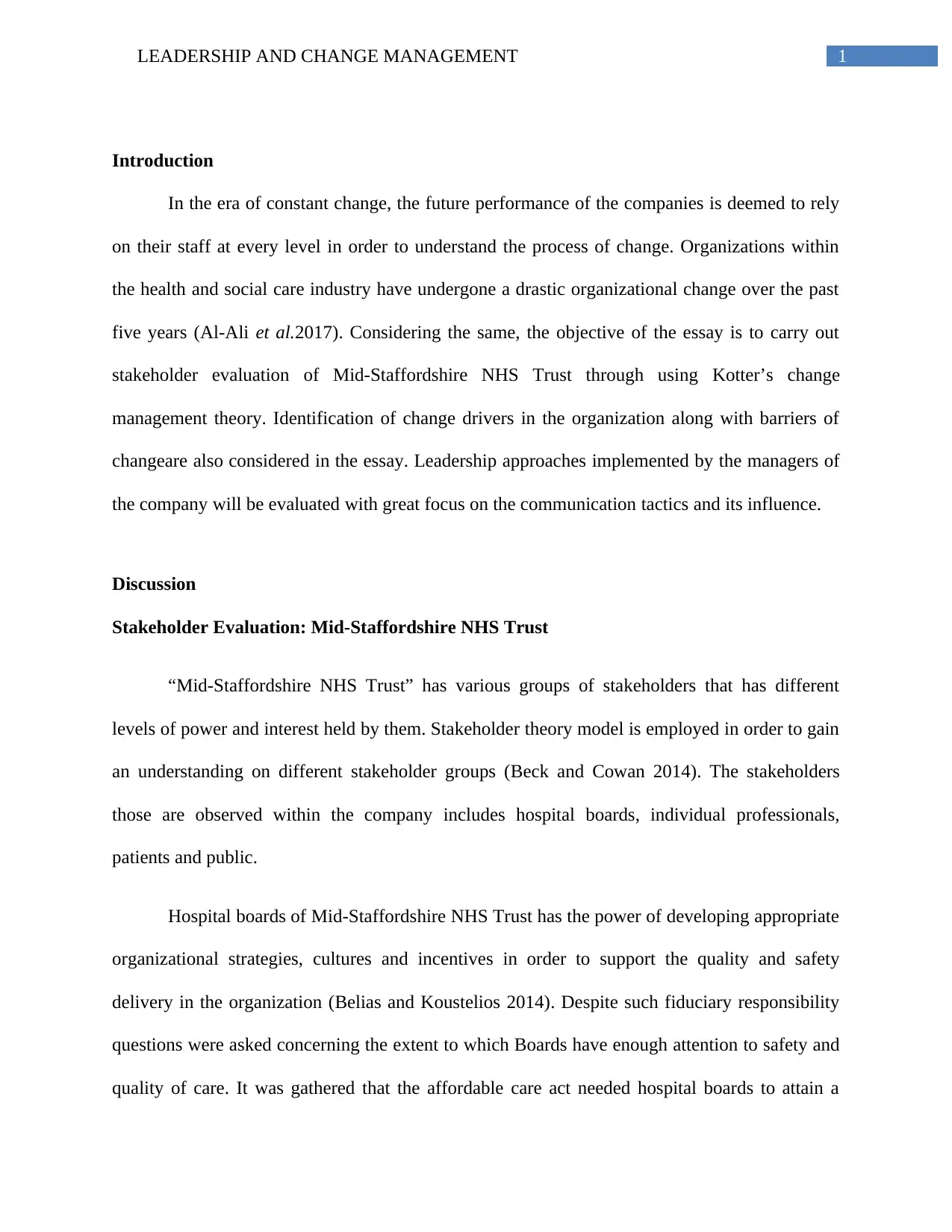
1LEADERSHIP AND CHANGE MANAGEMENT
Introduction
In the era of constant change, the future performance of the companies is deemed to rely
on their staff at every level in order to understand the process of change. Organizations within
the health and social care industry have undergone a drastic organizational change over the past
five years (Al-Ali et al.2017). Considering the same, the objective of the essay is to carry out
stakeholder evaluation of Mid-Staffordshire NHS Trust through using Kotter’s change
management theory. Identification of change drivers in the organization along with barriers of
changeare also considered in the essay. Leadership approaches implemented by the managers of
the company will be evaluated with great focus on the communication tactics and its influence.
Discussion
Stakeholder Evaluation: Mid-Staffordshire NHS Trust
“Mid-Staffordshire NHS Trust” has various groups of stakeholders that has different
levels of power and interest held by them. Stakeholder theory model is employed in order to gain
an understanding on different stakeholder groups (Beck and Cowan 2014). The stakeholders
those are observed within the company includes hospital boards, individual professionals,
patients and public.
Hospital boards of Mid-Staffordshire NHS Trust has the power of developing appropriate
organizational strategies, cultures and incentives in order to support the quality and safety
delivery in the organization (Belias and Koustelios 2014). Despite such fiduciary responsibility
questions were asked concerning the extent to which Boards have enough attention to safety and
quality of care. It was gathered that the affordable care act needed hospital boards to attain a
Introduction
In the era of constant change, the future performance of the companies is deemed to rely
on their staff at every level in order to understand the process of change. Organizations within
the health and social care industry have undergone a drastic organizational change over the past
five years (Al-Ali et al.2017). Considering the same, the objective of the essay is to carry out
stakeholder evaluation of Mid-Staffordshire NHS Trust through using Kotter’s change
management theory. Identification of change drivers in the organization along with barriers of
changeare also considered in the essay. Leadership approaches implemented by the managers of
the company will be evaluated with great focus on the communication tactics and its influence.
Discussion
Stakeholder Evaluation: Mid-Staffordshire NHS Trust
“Mid-Staffordshire NHS Trust” has various groups of stakeholders that has different
levels of power and interest held by them. Stakeholder theory model is employed in order to gain
an understanding on different stakeholder groups (Beck and Cowan 2014). The stakeholders
those are observed within the company includes hospital boards, individual professionals,
patients and public.
Hospital boards of Mid-Staffordshire NHS Trust has the power of developing appropriate
organizational strategies, cultures and incentives in order to support the quality and safety
delivery in the organization (Belias and Koustelios 2014). Despite such fiduciary responsibility
questions were asked concerning the extent to which Boards have enough attention to safety and
quality of care. It was gathered that the affordable care act needed hospital boards to attain a
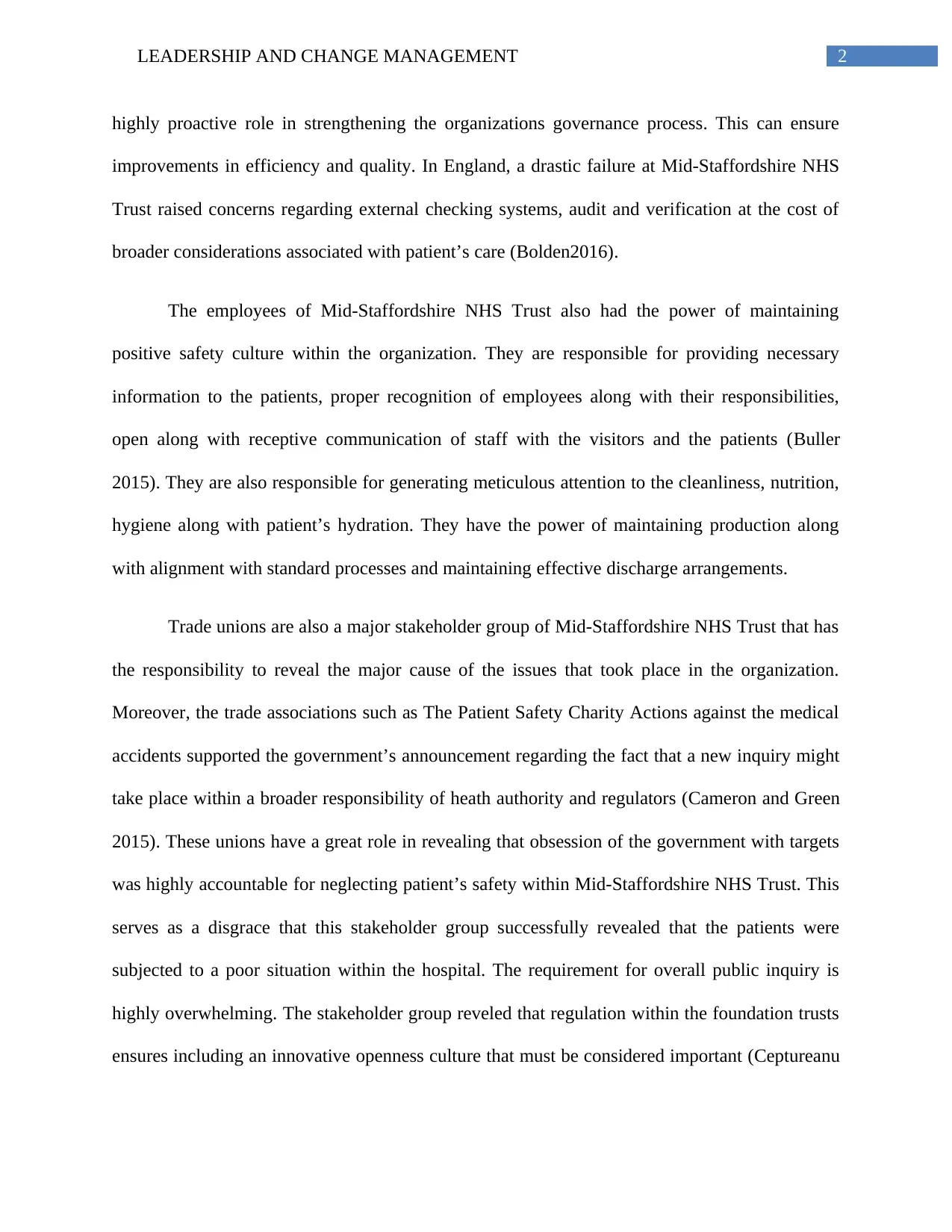
2LEADERSHIP AND CHANGE MANAGEMENT
highly proactive role in strengthening the organizations governance process. This can ensure
improvements in efficiency and quality. In England, a drastic failure at Mid-Staffordshire NHS
Trust raised concerns regarding external checking systems, audit and verification at the cost of
broader considerations associated with patient’s care (Bolden2016).
The employees of Mid-Staffordshire NHS Trust also had the power of maintaining
positive safety culture within the organization. They are responsible for providing necessary
information to the patients, proper recognition of employees along with their responsibilities,
open along with receptive communication of staff with the visitors and the patients (Buller
2015). They are also responsible for generating meticulous attention to the cleanliness, nutrition,
hygiene along with patient’s hydration. They have the power of maintaining production along
with alignment with standard processes and maintaining effective discharge arrangements.
Trade unions are also a major stakeholder group of Mid-Staffordshire NHS Trust that has
the responsibility to reveal the major cause of the issues that took place in the organization.
Moreover, the trade associations such as The Patient Safety Charity Actions against the medical
accidents supported the government’s announcement regarding the fact that a new inquiry might
take place within a broader responsibility of heath authority and regulators (Cameron and Green
2015). These unions have a great role in revealing that obsession of the government with targets
was highly accountable for neglecting patient’s safety within Mid-Staffordshire NHS Trust. This
serves as a disgrace that this stakeholder group successfully revealed that the patients were
subjected to a poor situation within the hospital. The requirement for overall public inquiry is
highly overwhelming. The stakeholder group reveled that regulation within the foundation trusts
ensures including an innovative openness culture that must be considered important (Ceptureanu
highly proactive role in strengthening the organizations governance process. This can ensure
improvements in efficiency and quality. In England, a drastic failure at Mid-Staffordshire NHS
Trust raised concerns regarding external checking systems, audit and verification at the cost of
broader considerations associated with patient’s care (Bolden2016).
The employees of Mid-Staffordshire NHS Trust also had the power of maintaining
positive safety culture within the organization. They are responsible for providing necessary
information to the patients, proper recognition of employees along with their responsibilities,
open along with receptive communication of staff with the visitors and the patients (Buller
2015). They are also responsible for generating meticulous attention to the cleanliness, nutrition,
hygiene along with patient’s hydration. They have the power of maintaining production along
with alignment with standard processes and maintaining effective discharge arrangements.
Trade unions are also a major stakeholder group of Mid-Staffordshire NHS Trust that has
the responsibility to reveal the major cause of the issues that took place in the organization.
Moreover, the trade associations such as The Patient Safety Charity Actions against the medical
accidents supported the government’s announcement regarding the fact that a new inquiry might
take place within a broader responsibility of heath authority and regulators (Cameron and Green
2015). These unions have a great role in revealing that obsession of the government with targets
was highly accountable for neglecting patient’s safety within Mid-Staffordshire NHS Trust. This
serves as a disgrace that this stakeholder group successfully revealed that the patients were
subjected to a poor situation within the hospital. The requirement for overall public inquiry is
highly overwhelming. The stakeholder group reveled that regulation within the foundation trusts
ensures including an innovative openness culture that must be considered important (Ceptureanu
⊘ This is a preview!⊘
Do you want full access?
Subscribe today to unlock all pages.

Trusted by 1+ million students worldwide
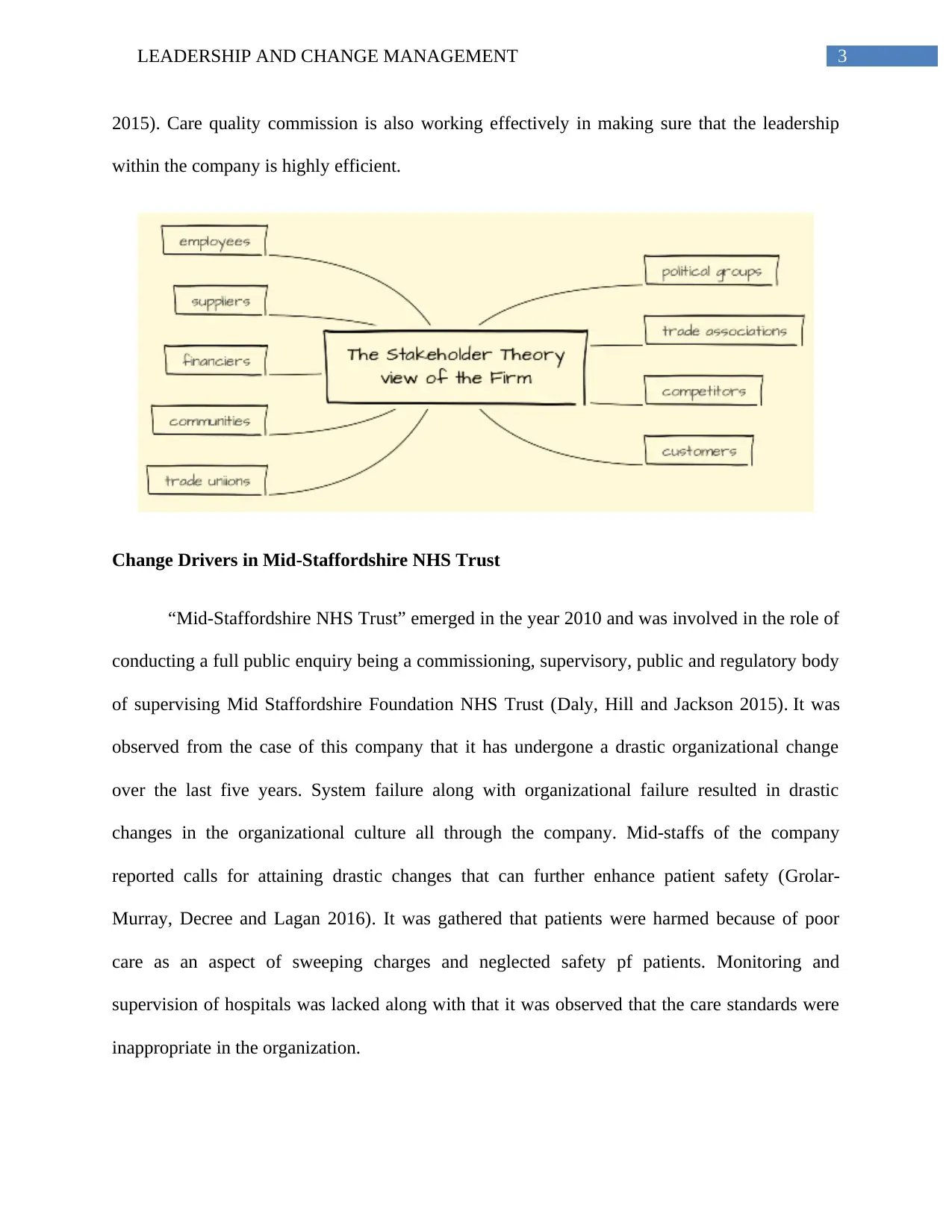
3LEADERSHIP AND CHANGE MANAGEMENT
2015). Care quality commission is also working effectively in making sure that the leadership
within the company is highly efficient.
Change Drivers in Mid-Staffordshire NHS Trust
“Mid-Staffordshire NHS Trust” emerged in the year 2010 and was involved in the role of
conducting a full public enquiry being a commissioning, supervisory, public and regulatory body
of supervising Mid Staffordshire Foundation NHS Trust (Daly, Hill and Jackson 2015). It was
observed from the case of this company that it has undergone a drastic organizational change
over the last five years. System failure along with organizational failure resulted in drastic
changes in the organizational culture all through the company. Mid-staffs of the company
reported calls for attaining drastic changes that can further enhance patient safety (Grolar-
Murray, Decree and Lagan 2016). It was gathered that patients were harmed because of poor
care as an aspect of sweeping charges and neglected safety pf patients. Monitoring and
supervision of hospitals was lacked along with that it was observed that the care standards were
inappropriate in the organization.
2015). Care quality commission is also working effectively in making sure that the leadership
within the company is highly efficient.
Change Drivers in Mid-Staffordshire NHS Trust
“Mid-Staffordshire NHS Trust” emerged in the year 2010 and was involved in the role of
conducting a full public enquiry being a commissioning, supervisory, public and regulatory body
of supervising Mid Staffordshire Foundation NHS Trust (Daly, Hill and Jackson 2015). It was
observed from the case of this company that it has undergone a drastic organizational change
over the last five years. System failure along with organizational failure resulted in drastic
changes in the organizational culture all through the company. Mid-staffs of the company
reported calls for attaining drastic changes that can further enhance patient safety (Grolar-
Murray, Decree and Lagan 2016). It was gathered that patients were harmed because of poor
care as an aspect of sweeping charges and neglected safety pf patients. Monitoring and
supervision of hospitals was lacked along with that it was observed that the care standards were
inappropriate in the organization.
Paraphrase This Document
Need a fresh take? Get an instant paraphrase of this document with our AI Paraphraser
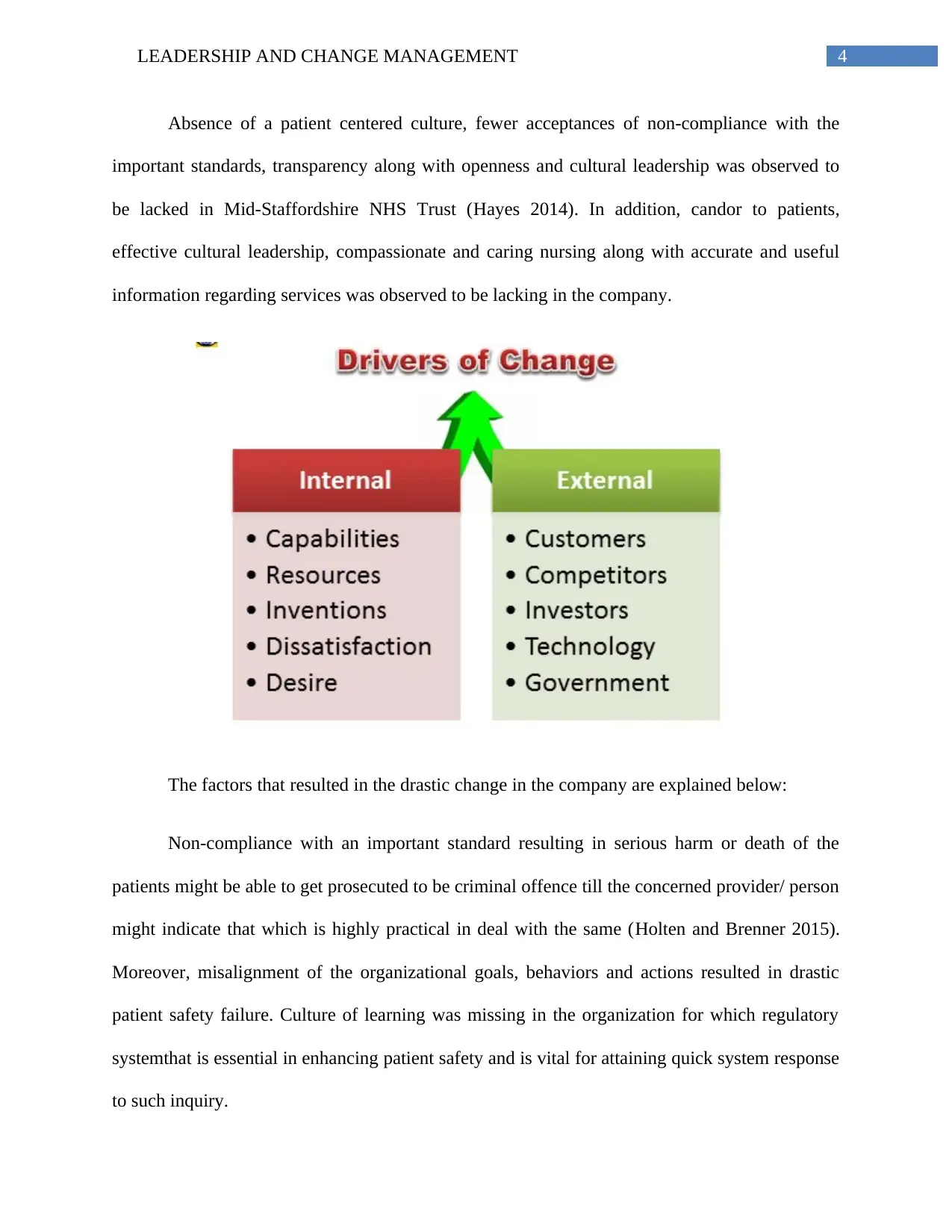
4LEADERSHIP AND CHANGE MANAGEMENT
Absence of a patient centered culture, fewer acceptances of non-compliance with the
important standards, transparency along with openness and cultural leadership was observed to
be lacked in Mid-Staffordshire NHS Trust (Hayes 2014). In addition, candor to patients,
effective cultural leadership, compassionate and caring nursing along with accurate and useful
information regarding services was observed to be lacking in the company.
The factors that resulted in the drastic change in the company are explained below:
Non-compliance with an important standard resulting in serious harm or death of the
patients might be able to get prosecuted to be criminal offence till the concerned provider/ person
might indicate that which is highly practical in deal with the same (Holten and Brenner 2015).
Moreover, misalignment of the organizational goals, behaviors and actions resulted in drastic
patient safety failure. Culture of learning was missing in the organization for which regulatory
systemthat is essential in enhancing patient safety and is vital for attaining quick system response
to such inquiry.
Absence of a patient centered culture, fewer acceptances of non-compliance with the
important standards, transparency along with openness and cultural leadership was observed to
be lacked in Mid-Staffordshire NHS Trust (Hayes 2014). In addition, candor to patients,
effective cultural leadership, compassionate and caring nursing along with accurate and useful
information regarding services was observed to be lacking in the company.
The factors that resulted in the drastic change in the company are explained below:
Non-compliance with an important standard resulting in serious harm or death of the
patients might be able to get prosecuted to be criminal offence till the concerned provider/ person
might indicate that which is highly practical in deal with the same (Holten and Brenner 2015).
Moreover, misalignment of the organizational goals, behaviors and actions resulted in drastic
patient safety failure. Culture of learning was missing in the organization for which regulatory
systemthat is essential in enhancing patient safety and is vital for attaining quick system response
to such inquiry.
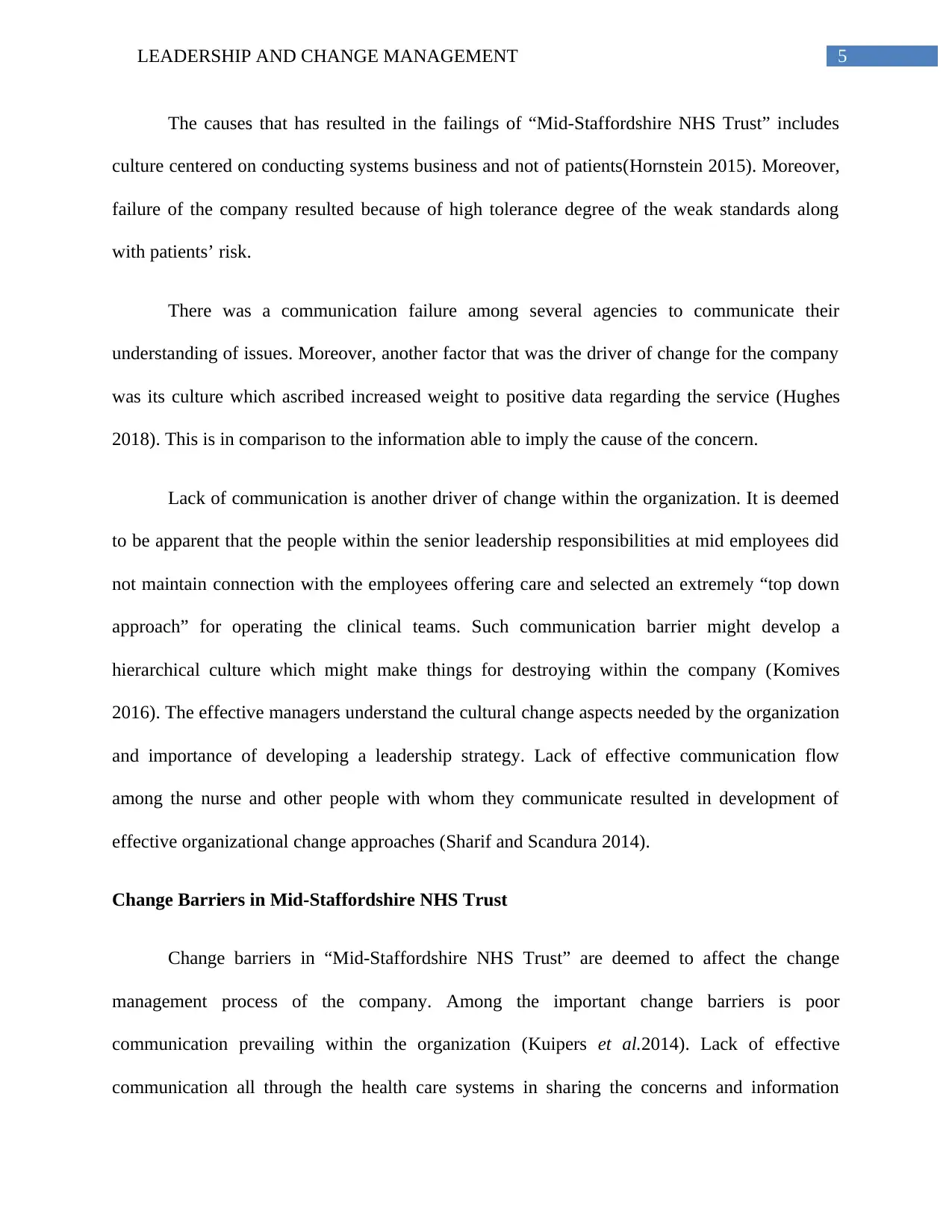
5LEADERSHIP AND CHANGE MANAGEMENT
The causes that has resulted in the failings of “Mid-Staffordshire NHS Trust” includes
culture centered on conducting systems business and not of patients(Hornstein 2015). Moreover,
failure of the company resulted because of high tolerance degree of the weak standards along
with patients’ risk.
There was a communication failure among several agencies to communicate their
understanding of issues. Moreover, another factor that was the driver of change for the company
was its culture which ascribed increased weight to positive data regarding the service (Hughes
2018). This is in comparison to the information able to imply the cause of the concern.
Lack of communication is another driver of change within the organization. It is deemed
to be apparent that the people within the senior leadership responsibilities at mid employees did
not maintain connection with the employees offering care and selected an extremely “top down
approach” for operating the clinical teams. Such communication barrier might develop a
hierarchical culture which might make things for destroying within the company (Komives
2016). The effective managers understand the cultural change aspects needed by the organization
and importance of developing a leadership strategy. Lack of effective communication flow
among the nurse and other people with whom they communicate resulted in development of
effective organizational change approaches (Sharif and Scandura 2014).
Change Barriers in Mid-Staffordshire NHS Trust
Change barriers in “Mid-Staffordshire NHS Trust” are deemed to affect the change
management process of the company. Among the important change barriers is poor
communication prevailing within the organization (Kuipers et al.2014). Lack of effective
communication all through the health care systems in sharing the concerns and information
The causes that has resulted in the failings of “Mid-Staffordshire NHS Trust” includes
culture centered on conducting systems business and not of patients(Hornstein 2015). Moreover,
failure of the company resulted because of high tolerance degree of the weak standards along
with patients’ risk.
There was a communication failure among several agencies to communicate their
understanding of issues. Moreover, another factor that was the driver of change for the company
was its culture which ascribed increased weight to positive data regarding the service (Hughes
2018). This is in comparison to the information able to imply the cause of the concern.
Lack of communication is another driver of change within the organization. It is deemed
to be apparent that the people within the senior leadership responsibilities at mid employees did
not maintain connection with the employees offering care and selected an extremely “top down
approach” for operating the clinical teams. Such communication barrier might develop a
hierarchical culture which might make things for destroying within the company (Komives
2016). The effective managers understand the cultural change aspects needed by the organization
and importance of developing a leadership strategy. Lack of effective communication flow
among the nurse and other people with whom they communicate resulted in development of
effective organizational change approaches (Sharif and Scandura 2014).
Change Barriers in Mid-Staffordshire NHS Trust
Change barriers in “Mid-Staffordshire NHS Trust” are deemed to affect the change
management process of the company. Among the important change barriers is poor
communication prevailing within the organization (Kuipers et al.2014). Lack of effective
communication all through the health care systems in sharing the concerns and information
⊘ This is a preview!⊘
Do you want full access?
Subscribe today to unlock all pages.

Trusted by 1+ million students worldwide
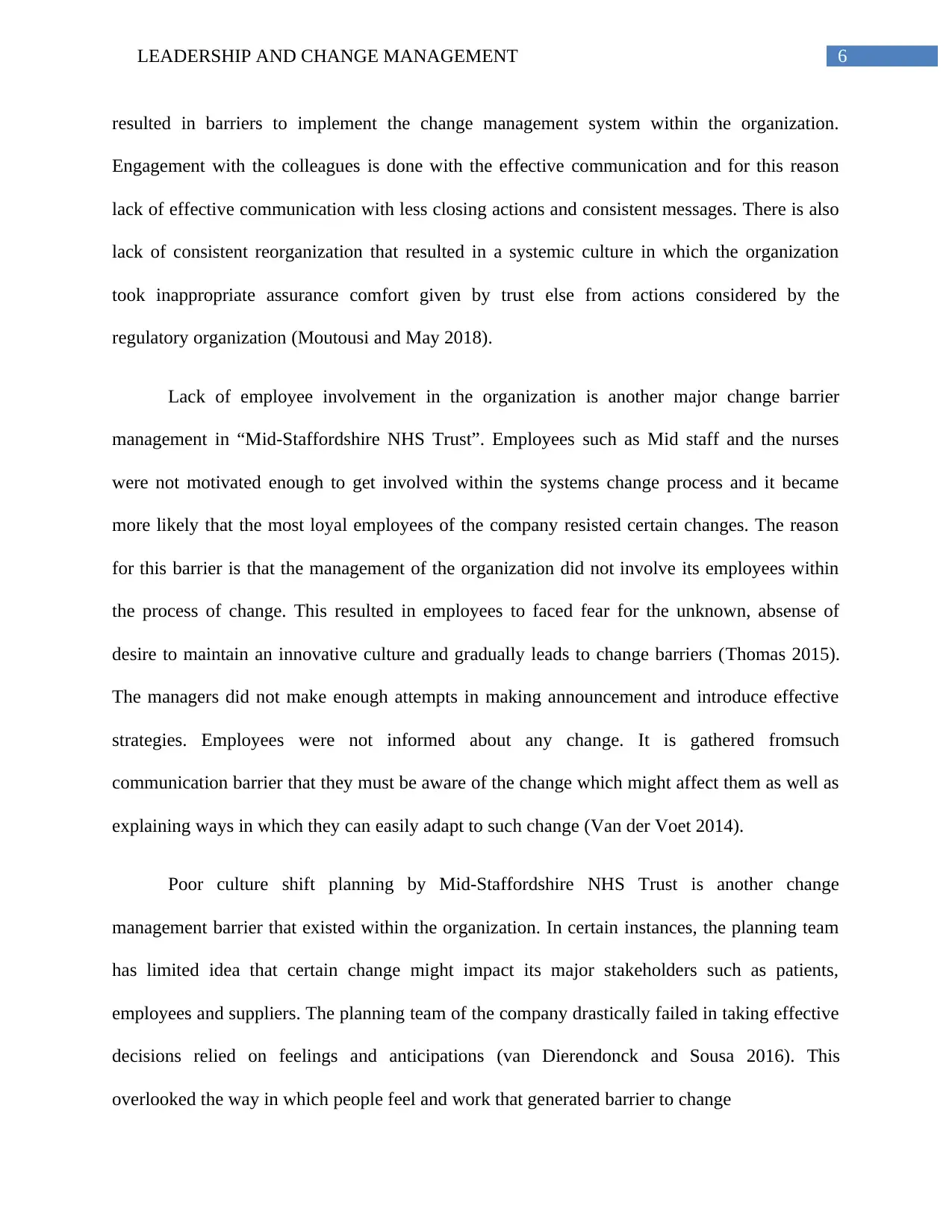
6LEADERSHIP AND CHANGE MANAGEMENT
resulted in barriers to implement the change management system within the organization.
Engagement with the colleagues is done with the effective communication and for this reason
lack of effective communication with less closing actions and consistent messages. There is also
lack of consistent reorganization that resulted in a systemic culture in which the organization
took inappropriate assurance comfort given by trust else from actions considered by the
regulatory organization (Moutousi and May 2018).
Lack of employee involvement in the organization is another major change barrier
management in “Mid-Staffordshire NHS Trust”. Employees such as Mid staff and the nurses
were not motivated enough to get involved within the systems change process and it became
more likely that the most loyal employees of the company resisted certain changes. The reason
for this barrier is that the management of the organization did not involve its employees within
the process of change. This resulted in employees to faced fear for the unknown, absense of
desire to maintain an innovative culture and gradually leads to change barriers (Thomas 2015).
The managers did not make enough attempts in making announcement and introduce effective
strategies. Employees were not informed about any change. It is gathered fromsuch
communication barrier that they must be aware of the change which might affect them as well as
explaining ways in which they can easily adapt to such change (Van der Voet 2014).
Poor culture shift planning by Mid-Staffordshire NHS Trust is another change
management barrier that existed within the organization. In certain instances, the planning team
has limited idea that certain change might impact its major stakeholders such as patients,
employees and suppliers. The planning team of the company drastically failed in taking effective
decisions relied on feelings and anticipations (van Dierendonck and Sousa 2016). This
overlooked the way in which people feel and work that generated barrier to change
resulted in barriers to implement the change management system within the organization.
Engagement with the colleagues is done with the effective communication and for this reason
lack of effective communication with less closing actions and consistent messages. There is also
lack of consistent reorganization that resulted in a systemic culture in which the organization
took inappropriate assurance comfort given by trust else from actions considered by the
regulatory organization (Moutousi and May 2018).
Lack of employee involvement in the organization is another major change barrier
management in “Mid-Staffordshire NHS Trust”. Employees such as Mid staff and the nurses
were not motivated enough to get involved within the systems change process and it became
more likely that the most loyal employees of the company resisted certain changes. The reason
for this barrier is that the management of the organization did not involve its employees within
the process of change. This resulted in employees to faced fear for the unknown, absense of
desire to maintain an innovative culture and gradually leads to change barriers (Thomas 2015).
The managers did not make enough attempts in making announcement and introduce effective
strategies. Employees were not informed about any change. It is gathered fromsuch
communication barrier that they must be aware of the change which might affect them as well as
explaining ways in which they can easily adapt to such change (Van der Voet 2014).
Poor culture shift planning by Mid-Staffordshire NHS Trust is another change
management barrier that existed within the organization. In certain instances, the planning team
has limited idea that certain change might impact its major stakeholders such as patients,
employees and suppliers. The planning team of the company drastically failed in taking effective
decisions relied on feelings and anticipations (van Dierendonck and Sousa 2016). This
overlooked the way in which people feel and work that generated barrier to change
Paraphrase This Document
Need a fresh take? Get an instant paraphrase of this document with our AI Paraphraser
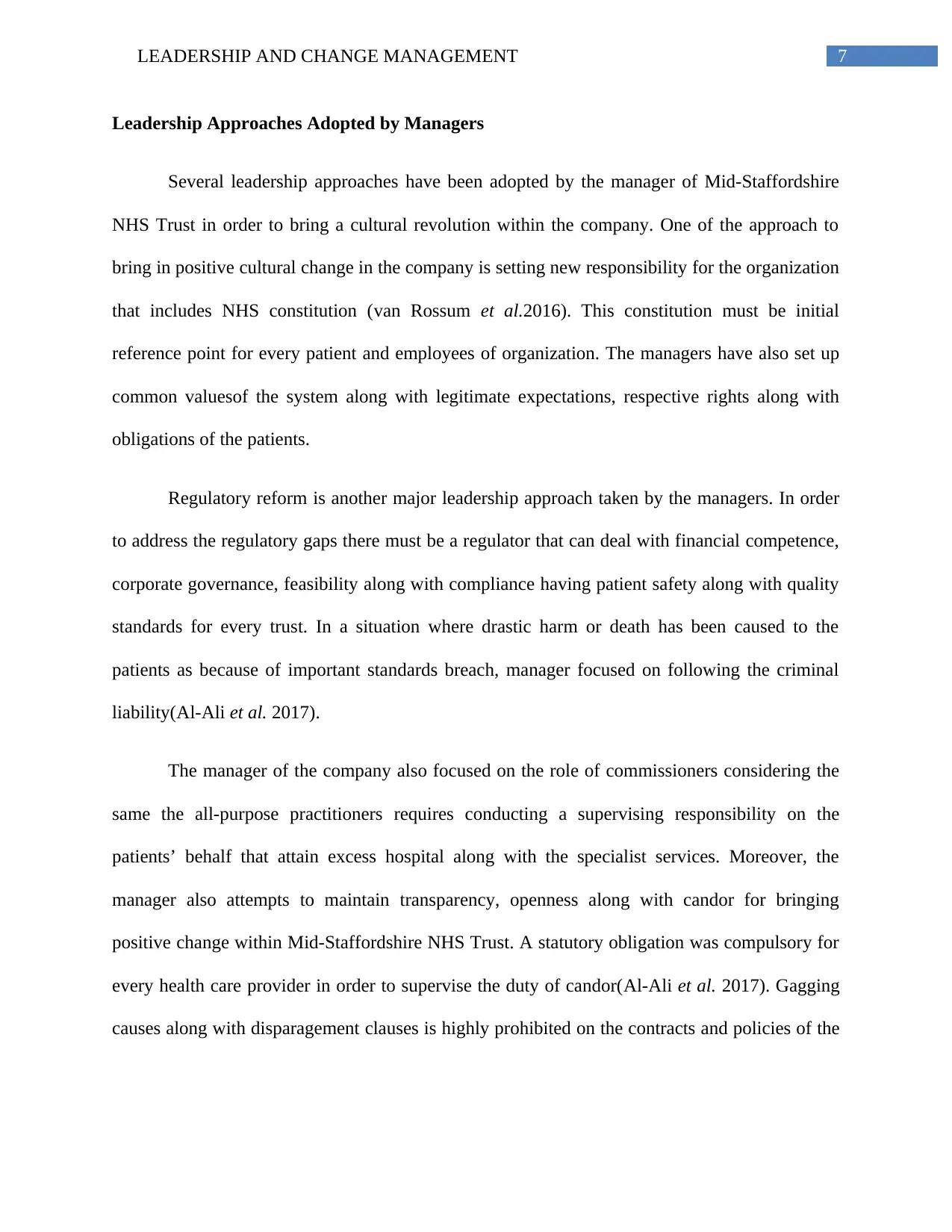
7LEADERSHIP AND CHANGE MANAGEMENT
Leadership Approaches Adopted by Managers
Several leadership approaches have been adopted by the manager of Mid-Staffordshire
NHS Trust in order to bring a cultural revolution within the company. One of the approach to
bring in positive cultural change in the company is setting new responsibility for the organization
that includes NHS constitution (van Rossum et al.2016). This constitution must be initial
reference point for every patient and employees of organization. The managers have also set up
common valuesof the system along with legitimate expectations, respective rights along with
obligations of the patients.
Regulatory reform is another major leadership approach taken by the managers. In order
to address the regulatory gaps there must be a regulator that can deal with financial competence,
corporate governance, feasibility along with compliance having patient safety along with quality
standards for every trust. In a situation where drastic harm or death has been caused to the
patients as because of important standards breach, manager focused on following the criminal
liability(Al-Ali et al. 2017).
The manager of the company also focused on the role of commissioners considering the
same the all-purpose practitioners requires conducting a supervising responsibility on the
patients’ behalf that attain excess hospital along with the specialist services. Moreover, the
manager also attempts to maintain transparency, openness along with candor for bringing
positive change within Mid-Staffordshire NHS Trust. A statutory obligation was compulsory for
every health care provider in order to supervise the duty of candor(Al-Ali et al. 2017). Gagging
causes along with disparagement clauses is highly prohibited on the contracts and policies of the
Leadership Approaches Adopted by Managers
Several leadership approaches have been adopted by the manager of Mid-Staffordshire
NHS Trust in order to bring a cultural revolution within the company. One of the approach to
bring in positive cultural change in the company is setting new responsibility for the organization
that includes NHS constitution (van Rossum et al.2016). This constitution must be initial
reference point for every patient and employees of organization. The managers have also set up
common valuesof the system along with legitimate expectations, respective rights along with
obligations of the patients.
Regulatory reform is another major leadership approach taken by the managers. In order
to address the regulatory gaps there must be a regulator that can deal with financial competence,
corporate governance, feasibility along with compliance having patient safety along with quality
standards for every trust. In a situation where drastic harm or death has been caused to the
patients as because of important standards breach, manager focused on following the criminal
liability(Al-Ali et al. 2017).
The manager of the company also focused on the role of commissioners considering the
same the all-purpose practitioners requires conducting a supervising responsibility on the
patients’ behalf that attain excess hospital along with the specialist services. Moreover, the
manager also attempts to maintain transparency, openness along with candor for bringing
positive change within Mid-Staffordshire NHS Trust. A statutory obligation was compulsory for
every health care provider in order to supervise the duty of candor(Al-Ali et al. 2017). Gagging
causes along with disparagement clauses is highly prohibited on the contracts and policies of the
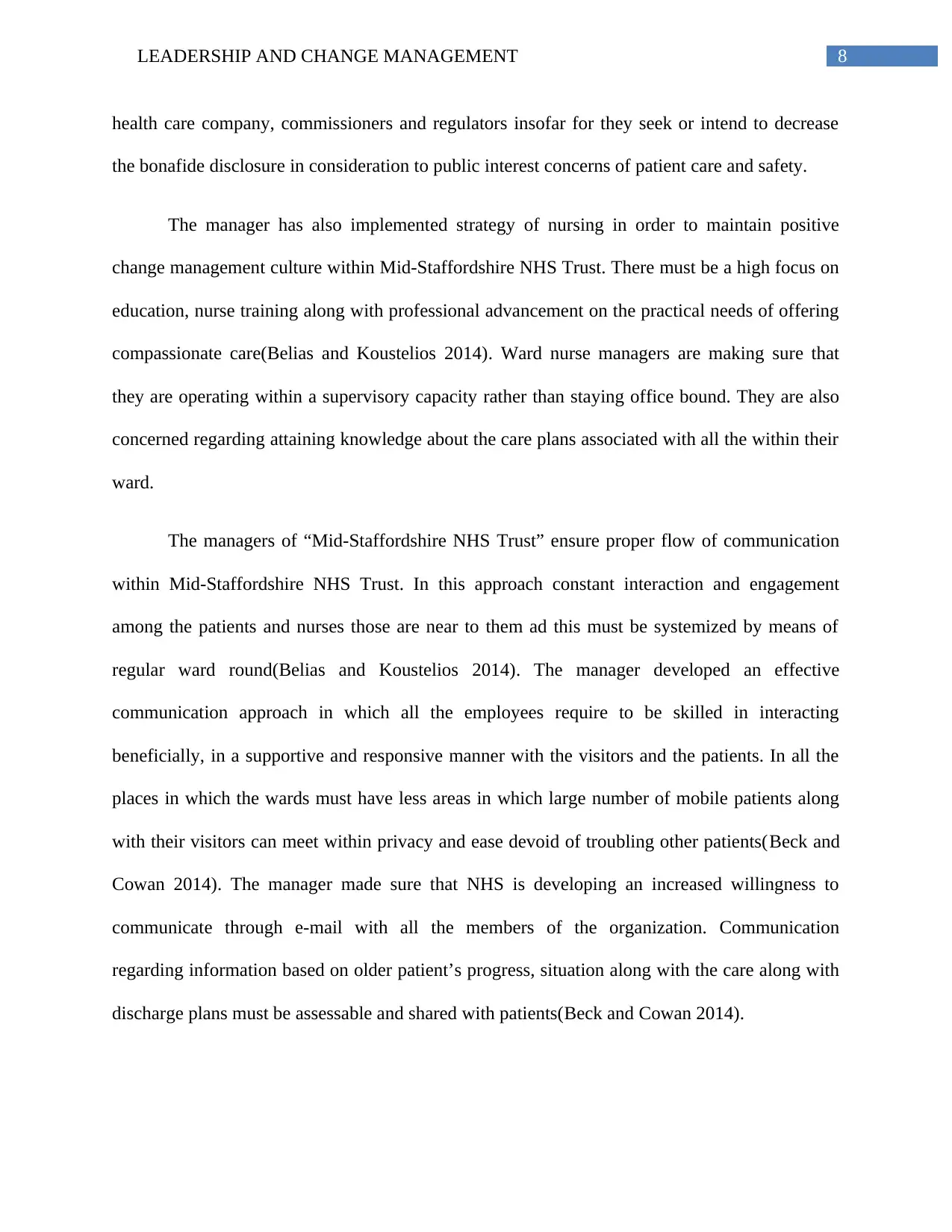
8LEADERSHIP AND CHANGE MANAGEMENT
health care company, commissioners and regulators insofar for they seek or intend to decrease
the bonafide disclosure in consideration to public interest concerns of patient care and safety.
The manager has also implemented strategy of nursing in order to maintain positive
change management culture within Mid-Staffordshire NHS Trust. There must be a high focus on
education, nurse training along with professional advancement on the practical needs of offering
compassionate care(Belias and Koustelios 2014). Ward nurse managers are making sure that
they are operating within a supervisory capacity rather than staying office bound. They are also
concerned regarding attaining knowledge about the care plans associated with all the within their
ward.
The managers of “Mid-Staffordshire NHS Trust” ensure proper flow of communication
within Mid-Staffordshire NHS Trust. In this approach constant interaction and engagement
among the patients and nurses those are near to them ad this must be systemized by means of
regular ward round(Belias and Koustelios 2014). The manager developed an effective
communication approach in which all the employees require to be skilled in interacting
beneficially, in a supportive and responsive manner with the visitors and the patients. In all the
places in which the wards must have less areas in which large number of mobile patients along
with their visitors can meet within privacy and ease devoid of troubling other patients(Beck and
Cowan 2014). The manager made sure that NHS is developing an increased willingness to
communicate through e-mail with all the members of the organization. Communication
regarding information based on older patient’s progress, situation along with the care along with
discharge plans must be assessable and shared with patients(Beck and Cowan 2014).
health care company, commissioners and regulators insofar for they seek or intend to decrease
the bonafide disclosure in consideration to public interest concerns of patient care and safety.
The manager has also implemented strategy of nursing in order to maintain positive
change management culture within Mid-Staffordshire NHS Trust. There must be a high focus on
education, nurse training along with professional advancement on the practical needs of offering
compassionate care(Belias and Koustelios 2014). Ward nurse managers are making sure that
they are operating within a supervisory capacity rather than staying office bound. They are also
concerned regarding attaining knowledge about the care plans associated with all the within their
ward.
The managers of “Mid-Staffordshire NHS Trust” ensure proper flow of communication
within Mid-Staffordshire NHS Trust. In this approach constant interaction and engagement
among the patients and nurses those are near to them ad this must be systemized by means of
regular ward round(Belias and Koustelios 2014). The manager developed an effective
communication approach in which all the employees require to be skilled in interacting
beneficially, in a supportive and responsive manner with the visitors and the patients. In all the
places in which the wards must have less areas in which large number of mobile patients along
with their visitors can meet within privacy and ease devoid of troubling other patients(Beck and
Cowan 2014). The manager made sure that NHS is developing an increased willingness to
communicate through e-mail with all the members of the organization. Communication
regarding information based on older patient’s progress, situation along with the care along with
discharge plans must be assessable and shared with patients(Beck and Cowan 2014).
⊘ This is a preview!⊘
Do you want full access?
Subscribe today to unlock all pages.

Trusted by 1+ million students worldwide
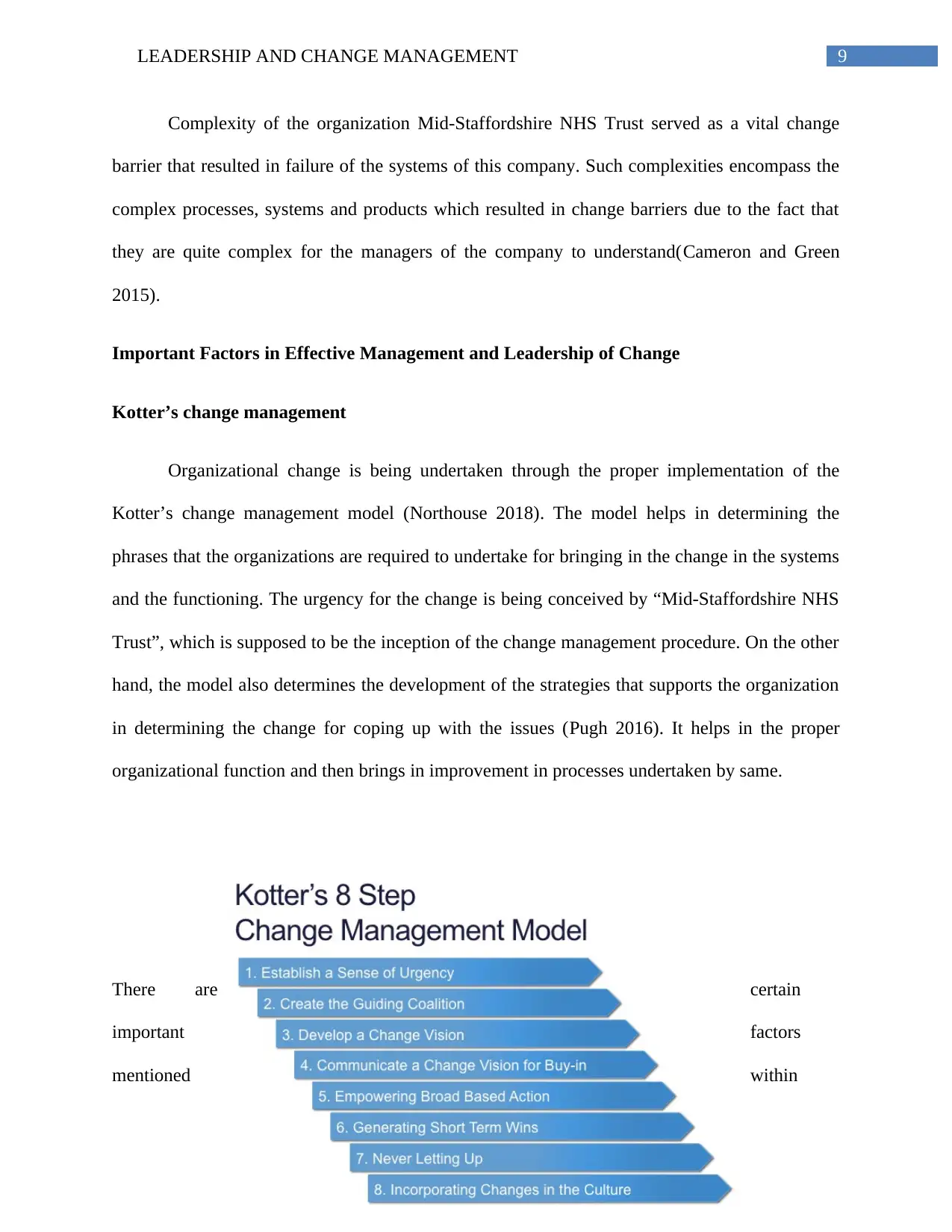
9LEADERSHIP AND CHANGE MANAGEMENT
Complexity of the organization Mid-Staffordshire NHS Trust served as a vital change
barrier that resulted in failure of the systems of this company. Such complexities encompass the
complex processes, systems and products which resulted in change barriers due to the fact that
they are quite complex for the managers of the company to understand(Cameron and Green
2015).
Important Factors in Effective Management and Leadership of Change
Kotter’s change management
Organizational change is being undertaken through the proper implementation of the
Kotter’s change management model (Northouse 2018). The model helps in determining the
phrases that the organizations are required to undertake for bringing in the change in the systems
and the functioning. The urgency for the change is being conceived by “Mid-Staffordshire NHS
Trust”, which is supposed to be the inception of the change management procedure. On the other
hand, the model also determines the development of the strategies that supports the organization
in determining the change for coping up with the issues (Pugh 2016). It helps in the proper
organizational function and then brings in improvement in processes undertaken by same.
There are certain
important factors
mentioned within
Complexity of the organization Mid-Staffordshire NHS Trust served as a vital change
barrier that resulted in failure of the systems of this company. Such complexities encompass the
complex processes, systems and products which resulted in change barriers due to the fact that
they are quite complex for the managers of the company to understand(Cameron and Green
2015).
Important Factors in Effective Management and Leadership of Change
Kotter’s change management
Organizational change is being undertaken through the proper implementation of the
Kotter’s change management model (Northouse 2018). The model helps in determining the
phrases that the organizations are required to undertake for bringing in the change in the systems
and the functioning. The urgency for the change is being conceived by “Mid-Staffordshire NHS
Trust”, which is supposed to be the inception of the change management procedure. On the other
hand, the model also determines the development of the strategies that supports the organization
in determining the change for coping up with the issues (Pugh 2016). It helps in the proper
organizational function and then brings in improvement in processes undertaken by same.
There are certain
important factors
mentioned within
Paraphrase This Document
Need a fresh take? Get an instant paraphrase of this document with our AI Paraphraser
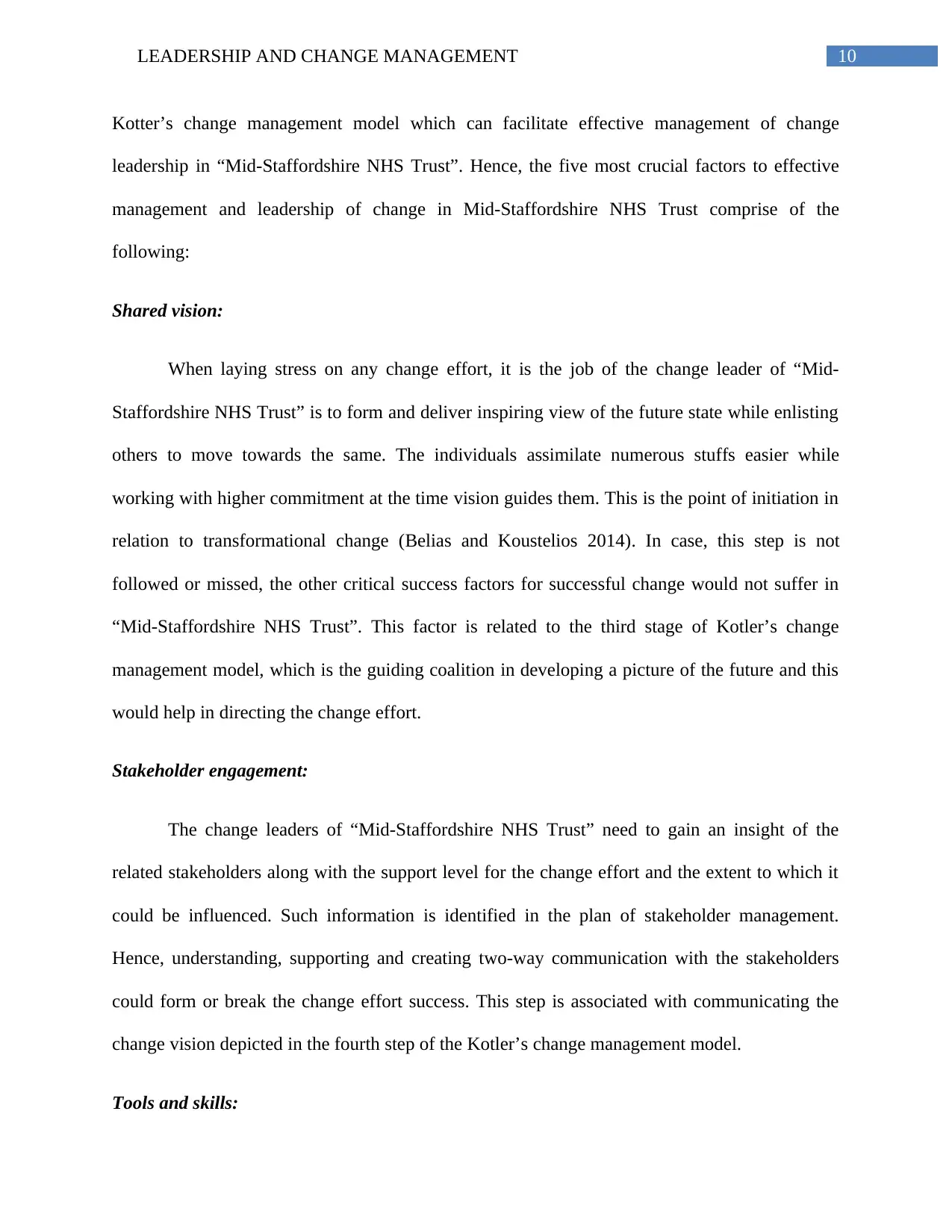
10LEADERSHIP AND CHANGE MANAGEMENT
Kotter’s change management model which can facilitate effective management of change
leadership in “Mid-Staffordshire NHS Trust”. Hence, the five most crucial factors to effective
management and leadership of change in Mid-Staffordshire NHS Trust comprise of the
following:
Shared vision:
When laying stress on any change effort, it is the job of the change leader of “Mid-
Staffordshire NHS Trust” is to form and deliver inspiring view of the future state while enlisting
others to move towards the same. The individuals assimilate numerous stuffs easier while
working with higher commitment at the time vision guides them. This is the point of initiation in
relation to transformational change (Belias and Koustelios 2014). In case, this step is not
followed or missed, the other critical success factors for successful change would not suffer in
“Mid-Staffordshire NHS Trust”. This factor is related to the third stage of Kotler’s change
management model, which is the guiding coalition in developing a picture of the future and this
would help in directing the change effort.
Stakeholder engagement:
The change leaders of “Mid-Staffordshire NHS Trust” need to gain an insight of the
related stakeholders along with the support level for the change effort and the extent to which it
could be influenced. Such information is identified in the plan of stakeholder management.
Hence, understanding, supporting and creating two-way communication with the stakeholders
could form or break the change effort success. This step is associated with communicating the
change vision depicted in the fourth step of the Kotler’s change management model.
Tools and skills:
Kotter’s change management model which can facilitate effective management of change
leadership in “Mid-Staffordshire NHS Trust”. Hence, the five most crucial factors to effective
management and leadership of change in Mid-Staffordshire NHS Trust comprise of the
following:
Shared vision:
When laying stress on any change effort, it is the job of the change leader of “Mid-
Staffordshire NHS Trust” is to form and deliver inspiring view of the future state while enlisting
others to move towards the same. The individuals assimilate numerous stuffs easier while
working with higher commitment at the time vision guides them. This is the point of initiation in
relation to transformational change (Belias and Koustelios 2014). In case, this step is not
followed or missed, the other critical success factors for successful change would not suffer in
“Mid-Staffordshire NHS Trust”. This factor is related to the third stage of Kotler’s change
management model, which is the guiding coalition in developing a picture of the future and this
would help in directing the change effort.
Stakeholder engagement:
The change leaders of “Mid-Staffordshire NHS Trust” need to gain an insight of the
related stakeholders along with the support level for the change effort and the extent to which it
could be influenced. Such information is identified in the plan of stakeholder management.
Hence, understanding, supporting and creating two-way communication with the stakeholders
could form or break the change effort success. This step is associated with communicating the
change vision depicted in the fourth step of the Kotler’s change management model.
Tools and skills:
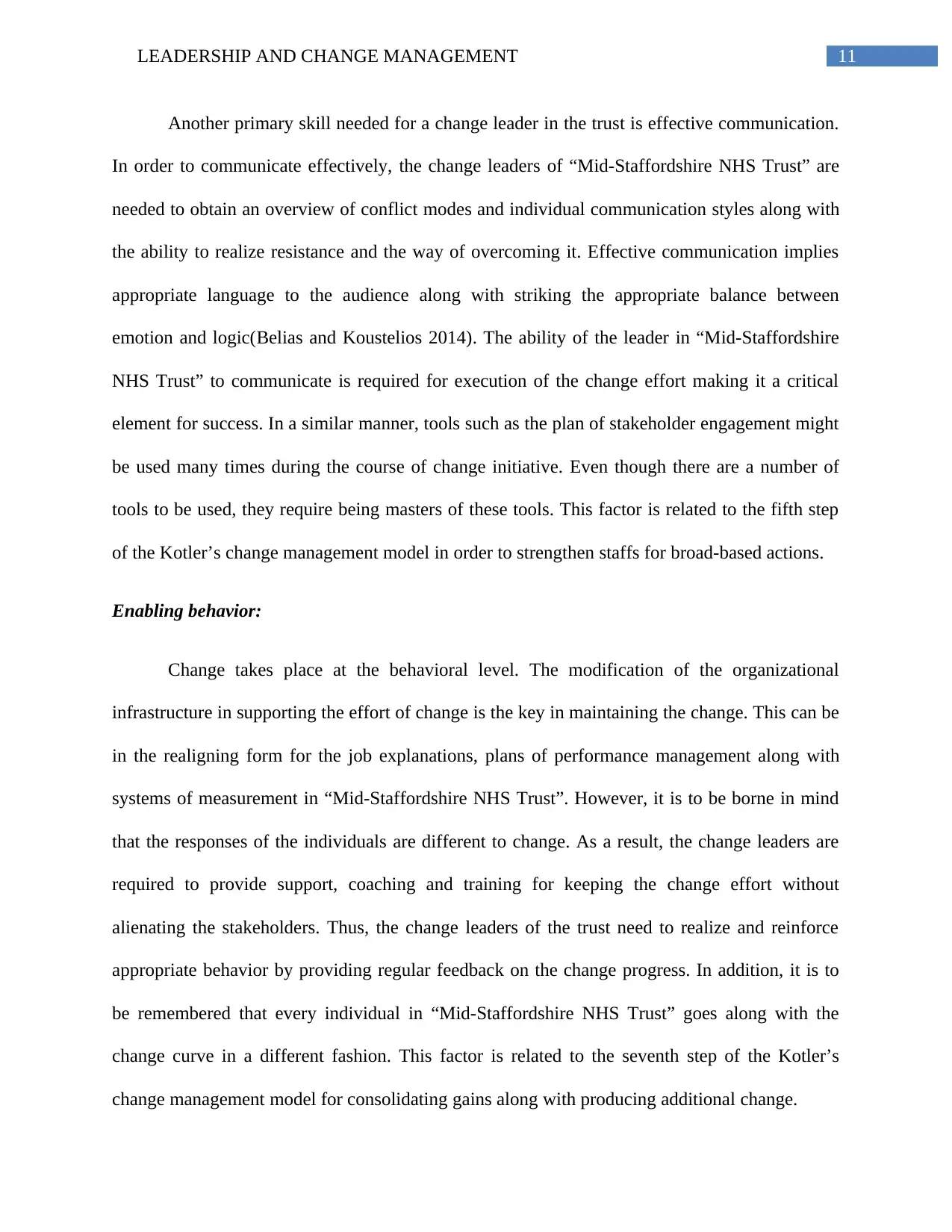
11LEADERSHIP AND CHANGE MANAGEMENT
Another primary skill needed for a change leader in the trust is effective communication.
In order to communicate effectively, the change leaders of “Mid-Staffordshire NHS Trust” are
needed to obtain an overview of conflict modes and individual communication styles along with
the ability to realize resistance and the way of overcoming it. Effective communication implies
appropriate language to the audience along with striking the appropriate balance between
emotion and logic(Belias and Koustelios 2014). The ability of the leader in “Mid-Staffordshire
NHS Trust” to communicate is required for execution of the change effort making it a critical
element for success. In a similar manner, tools such as the plan of stakeholder engagement might
be used many times during the course of change initiative. Even though there are a number of
tools to be used, they require being masters of these tools. This factor is related to the fifth step
of the Kotler’s change management model in order to strengthen staffs for broad-based actions.
Enabling behavior:
Change takes place at the behavioral level. The modification of the organizational
infrastructure in supporting the effort of change is the key in maintaining the change. This can be
in the realigning form for the job explanations, plans of performance management along with
systems of measurement in “Mid-Staffordshire NHS Trust”. However, it is to be borne in mind
that the responses of the individuals are different to change. As a result, the change leaders are
required to provide support, coaching and training for keeping the change effort without
alienating the stakeholders. Thus, the change leaders of the trust need to realize and reinforce
appropriate behavior by providing regular feedback on the change progress. In addition, it is to
be remembered that every individual in “Mid-Staffordshire NHS Trust” goes along with the
change curve in a different fashion. This factor is related to the seventh step of the Kotler’s
change management model for consolidating gains along with producing additional change.
Another primary skill needed for a change leader in the trust is effective communication.
In order to communicate effectively, the change leaders of “Mid-Staffordshire NHS Trust” are
needed to obtain an overview of conflict modes and individual communication styles along with
the ability to realize resistance and the way of overcoming it. Effective communication implies
appropriate language to the audience along with striking the appropriate balance between
emotion and logic(Belias and Koustelios 2014). The ability of the leader in “Mid-Staffordshire
NHS Trust” to communicate is required for execution of the change effort making it a critical
element for success. In a similar manner, tools such as the plan of stakeholder engagement might
be used many times during the course of change initiative. Even though there are a number of
tools to be used, they require being masters of these tools. This factor is related to the fifth step
of the Kotler’s change management model in order to strengthen staffs for broad-based actions.
Enabling behavior:
Change takes place at the behavioral level. The modification of the organizational
infrastructure in supporting the effort of change is the key in maintaining the change. This can be
in the realigning form for the job explanations, plans of performance management along with
systems of measurement in “Mid-Staffordshire NHS Trust”. However, it is to be borne in mind
that the responses of the individuals are different to change. As a result, the change leaders are
required to provide support, coaching and training for keeping the change effort without
alienating the stakeholders. Thus, the change leaders of the trust need to realize and reinforce
appropriate behavior by providing regular feedback on the change progress. In addition, it is to
be remembered that every individual in “Mid-Staffordshire NHS Trust” goes along with the
change curve in a different fashion. This factor is related to the seventh step of the Kotler’s
change management model for consolidating gains along with producing additional change.
⊘ This is a preview!⊘
Do you want full access?
Subscribe today to unlock all pages.

Trusted by 1+ million students worldwide
1 out of 16
Related Documents
Your All-in-One AI-Powered Toolkit for Academic Success.
+13062052269
info@desklib.com
Available 24*7 on WhatsApp / Email
![[object Object]](/_next/static/media/star-bottom.7253800d.svg)
Unlock your academic potential
Copyright © 2020–2025 A2Z Services. All Rights Reserved. Developed and managed by ZUCOL.





